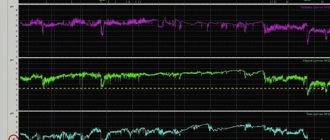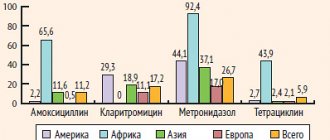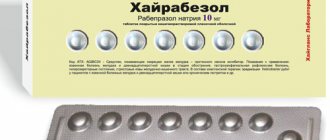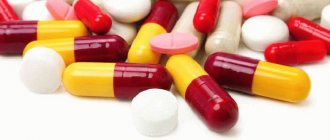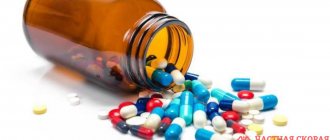Ganaton®
Suction
Itopride hydrochloride is rapidly and almost completely absorbed from the gastrointestinal tract. Relative bioavailability is 60%, which is due to first-pass metabolism through the liver. Food has no effect on bioavailability. The maximum concentration in blood plasma (Cmax 0.28 mcg/ml) is achieved 0.5-0.75 hours after taking 50 mg of itopride hydrochloride.
When itopride hydrochloride was repeatedly taken orally at a dose of 50-200 mg three times a day for 7 days, the pharmacokinetics of the drug and its metabolites were linear, and accumulation was minimal.
Distribution
Itopride hydrochloride is 96% bound to plasma proteins, mainly albumin. Binding to alpha1-acid glycoprotein accounts for less than 15% of total binding.
Itopride is actively distributed into tissue (volume of distribution Vdβ = 6.1 l/kg) and is found in high concentrations in the kidneys, small intestine, liver, adrenal glands and stomach. Penetration into the brain and spinal cord is minimal. Itopride passes into breast milk.
Metabolism
Itopride undergoes active biotransformation in the human liver. 3 metabolites have been identified, only one of which exhibits small activity that has no pharmacological significance (approximately 2-3% of that of itopride). The primary metabolite in humans is N-oxide, which is formed as a result of oxidation of the tertiary amino-N-dimethyl group.
Itopride is metabolized by flavin-dependent monooxygenase (FMO3). The amount and effectiveness of FMO isoenzymes in humans may vary due to genetic polymorphisms, which in rare cases lead to the development of an autosomal recessive condition known as trimethylaminuria (fishy odor syndrome).
According to pharmacokinetic studies of CYP-mediated reactions in vivo, itopride does not have an inhibitory or inducing effect on the CYP2C19 and CYP2E1 isoenzymes. Itopride therapy does not affect CYP or uridine diphosphate glucuronyl transferase activity.
Removal
Itopride hydrochloride and its metabolites are excreted mainly in the urine. Renal excretion of itopride and its N-oxide after a single oral dose of the drug at a therapeutic dose (50 mg) in healthy people was 3.7 and 75.4%, respectively. The half-life of itopride hydrochloride is approximately 6 hours.
Ganaton, 70 pcs., 50 mg, film-coated tablets
Ganaton - stimulating the tone and motility of the gastrointestinal tract.
Pharmacodynamics
Mechanism of action. Itopride hydrochloride enhances gastric motility by antagonizing D2-dopamine receptors and inhibiting acetylcholinesterase. Itopride activates the release of acetylcholine and inhibits its destruction.
Itopride hydrochloride also provides an antiemetic effect due to interaction with D2 receptors located in the trigger zone. Itopride causes dose-dependent suppression of apomorphine-induced vomiting.
Itopride hydrochloride activates propulsive gastric motility through antagonism of D2 receptors and dose-dependent inhibition of acetylcholinesterase activity.
Itopride hydrochloride has a specific effect on the upper gastrointestinal tract, accelerates gastric transit and improves gastric emptying. Itopride hydrochloride does not affect serum gastrin levels.
Pharmacokinetics
Suction. Itopride hydrochloride is rapidly and almost completely absorbed from the gastrointestinal tract. Its relative bioavailability is 60%, which is associated with first-pass metabolism through the liver. Food has no effect on bioavailability.
After taking 50 mg of itopride hydrochloride orally, Cmax is reached after 0.5–0.75 hours and is 0.28 mcg/ml. When the drug was repeated at a dose of 50–200 mg 3 times a day for 7 days, the pharmacokinetics of the drug and its metabolites were linear, and accumulation was minimal.
Distribution. Binds to plasma proteins (mainly albumin) by 96%. Binding to α1-acid glycoprotein accounts for less than 15% of total binding.
Actively distributed in tissues (Vd is 6.1 l/kg) and is found in high concentrations in the kidneys, small intestine, liver, adrenal glands and stomach. Penetrates the brain and spinal cord in minimal quantities. Passes into breast milk.
Metabolism. Itopride undergoes active biotransformation in the liver. 3 metabolites have been identified, only one of which exhibits small activity that has no pharmacological significance (approximately 2–3% of that of itopride). The primary metabolite is N-oxide, which is formed as a result of oxidation of the quaternary amino-N-dimethyl group.
Itopride is metabolized by flavin-dependent monooxygenase (FMO3). The amount and effectiveness of FMO3 isoenzymes in humans may vary depending on genetic polymorphisms, which in rare cases lead to the development of an autosomal recessive condition known as trimethylaminuria (fishy odor syndrome). In patients with trimethylaminuria, T1/2 of itopride increases.
According to in vivo pharmacokinetic studies, itopride does not have an inhibitory or inducing effect on CYP2C19 and CYP2E1. Itopride therapy does not affect CYP or uridine diphosphate glucuronyl transferase activity.
Excretion. Itopride hydrochloride and its metabolites are excreted mainly in the urine. Renal excretion of itopride and its N-oxide after a single oral dose of the drug in therapeutic doses in healthy people was 3.7 and 75.4%, respectively.
Terminal T1/2 of itopride hydrochloride is about 6 hours.
The effectiveness of the drug Ganaton in the treatment of patients with GERD
Gastroesophageal reflux disease (GERD) is a disease caused by impaired peristalsis of the organs of the esophagogastroduodenal zone, frequently repeated reflux of gastric or duodenal contents into the esophagus, and prolonged exposure of refluxate in the esophagus, leading to damage to the distal part of the esophagus.
Table 1. Heartburn assessment of the studied patients
Table 2. Results of endoscopic examination before the start of therapy
Graph 1. Dynamics of patients’ well-being (VAS assessment) before and after treatment
Graph 2. Dynamics of the Kerdo vegetative index before and after treatment with Ganaton
Graph 3. Dynamics of quality of life (physical health) according to the SF-36 questionnaire
Graph 4. Dynamics of the level of quality of life (mental health) according to the SF-36 questionnaire
From the definition of the disease it is clear that the main pathogenetic mechanism that creates the conditions for irritation, inflammation, and damage to the mucous membrane is a motility disorder. However, the main line of therapy used in the treatment of GERD is blockade of gastric secretion. This is largely due to the fact that until now there have been no effective drugs that restore impaired peristalsis, and those that were present on the pharmacological market had a significant number of side effects.
It should be noted that in clinical practice, blockade of gastric secretion does not always effectively solve the problem of controlling the symptoms of GERD. In such cases (and this is, for example, a combination of heartburn with symptoms of dyspepsia, resistance to proton pump inhibitors or nighttime acidity breakthroughs during therapy with these drugs, alkaline reflux, etc.), the importance of restoring normal motor function of the esophagus and stomach increases.
In 2007, a new prokinetic agent with a combined mechanism of action was registered in Russia - Ganaton (Ganaton is a kind of abbreviation for “ ga
stric
na
tural
ton
e", i.e. restoring normal stomach tone; international name: itopride hydrochloride).
Ganatone (itopride hydrochloride) is both a dopamine receptor antagonist and an acetylcholinesterase blocker. The drug activates the release of acetylcholine and prevents its degradation.
Ganaton has minimal ability to penetrate the blood-brain barrier into the central nervous system, including the brain and spinal cord. Metabolism of the drug allows you to avoid unwanted drug interactions when taking drugs metabolized by enzymes of the cytochrome P 450 system.
For adults, Ganaton is prescribed orally, 1 tablet (50 mg) 3 times a day before meals. The recommended daily dose is 150 mg.
In Japan, where Ganaton (itopride hydrochloride) has been used since 1995, a multicenter, double-blind comparative study of the effectiveness of use for 2 weeks in patients with chronic gastritis with symptoms of dyspepsia was conducted. Itopride hydrochloride was prescribed at a dose of 50 mg 3 times a day (in 111 patients), cisapride - at a dose of 2.5 mg 3 times a day (in 114 patients) (3). Moderate or significant clinical improvement was observed in 79.3% of patients receiving itopride hydrochloride and in 71.9% of patients receiving cisapride. The authors concluded that the use of itopride hydrochloride is highly effective in the treatment of patients with chronic gastritis with symptoms of dyspepsia. A good effect of itopride hydrochloride was also noted in patients with chronic gastritis with concomitant symptoms of gastroesophageal reflux disease (2), as well as in patients with diabetic gastroparesis (5).
In all clinical studies, Ganaton (itopride hydrochloride) has proven itself to be a drug characterized by good tolerability and the absence of serious side effects. The main side effects when taking itopride hydrochloride were: diarrhea (0.7% of cases), abdominal pain (0.3%), headache (0.3%). Post-marketing studies have confirmed the safety of itopride hydrochloride (1). The results of the use of this drug in more than 10 million patients did not reveal a single case of prolongation of the QT interval. When the drug is prescribed in usual therapeutic doses, an increase in the level of prolactin in the blood is rare.
At a special symposium on the treatment of functional dyspepsia, which was held in 2005 in Montreal as part of the World Congress of Gastroenterology, Ganaton (itopride hydrochloride) was characterized as a highly effective and safe representative of a new class of prokinetics, which can be successfully used in the treatment of functional dyspepsia, and in in the future, it may take an important place in the treatment of other gastroenterological diseases that occur with impaired motor function of the stomach (idiopathic gastroparesis, gastroesophageal reflux disease, etc.) (4).
At the Department of Gastroenterology of the Federal State Institution UMMC UD of the President of the Russian Federation, in the period from April to June 2008, a study of clinical use was conducted, providing for a course of treatment with Ganaton according to a standard regimen for 4 weeks in patients with GERD.
The purpose of the study is to evaluate the effectiveness of a 4-week course of therapy with Ganaton in a standard mode in relieving the symptoms of GERD and the effect on the quality of life of patients, as well as on the tone of the ANS (elimination of dysfunction of the sympathetic and parasympathetic type).
The inclusion criteria for patients were: the presence of moderate or severe heartburn in patients (³ 2 points on the Likert scale), at least 1-2 times a week, the presence of ANS dysfunction of the sympathetic or parasympathetic type.
A total of 20 male patients with GERD stages 0–1, aged from 20 to 25 years (mean age 22.8 ± 0.33 years), who met the inclusion criteria, were accepted for the study.
Before inclusion, clinical blood and urine tests and endoscopy were performed. Before and after treatment, the intensity and frequency of symptoms, the endoscopic picture in patients with the erosive form of GERD and the level of quality of life were assessed according to the SF-36 questionnaire and the visual analogue scale (VAS).
Patients took Ganaton at a dose of 1 tablet 3 times a day, 15 minutes before meals for 25 days.
The type of GERD was recurrent in 100% of cases. The average duration of ENRB was 3.4 ± 0.65 years.
All patients at the time of inclusion in the treatment group experienced heartburn and other symptoms of GERD, which significantly worsened the quality of life.
Heartburn was assessed using a calculated score (Table 1).
The mean heartburn score was 7.0 ± 0.2 points.
The endoscopic characteristics of patients before treatment are presented in Table 2.
The study of vegetative status was carried out according to a special questionnaire (Vein M.V., 1993), an objective examination and the calculation of the Kerdo index:
- VI = (1 – D/R) ´ 100, where VI is the vegetative index;
- D – diastolic pressure;
- P – heart rate per minute.
Results of patient treatment
During monotherapy with Ganaton, heartburn decreased by 1 or more points by 7 ± 0.62 days of treatment in all patients and was completely relieved by 8.5 ± 1.1 days of therapy in 90% of cases. In 2 patients, there was no relief of GERD symptoms (heartburn, belching of air) at the end of therapy. This may be due to the fact that the mechanism for the formation of clinical manifestations in them was different - not related to a motor disorder.
In patients with the erosive form of GERD (6 patients), after completion of therapy, a control endoscopy was performed, which revealed complete epithelization of esophageal erosions in 100% of cases.
When assessing well-being using a visual analogue scale, the initial VAS data was 6.8 ± 0.38 cm, after a course of therapy – 8.7 ± 0.19 cm (p
A clear effect on the vegetative status was obtained, which is reflected in the improvement of clinical symptoms. Thus, the vegetative Kerdo index in patients with dysfunction of the nervous system of the parasympathetic type before treatment was 15.3 ± 1.8, after treatment – 13.1 ± 0.9. In patients with ANS dysfunction of the sympathetic type, the Kerdo index before treatment was 12.4 ± 1.8, after treatment – 11.2 ± 1.2. The results are presented in graph 2.
The dynamics of the level of quality of life according to the SF-36 questionnaire showed that among the indicators of the physical component of health (Graph 3), role functioning (RP), pain intensity (BP), and general health (GH) significantly improved. Among the indicators of the psychological component of health (Graph 4), there was a significant improvement in vital activity (VT), social (SF) and role (RE) functioning, and mental health (MHn).
Assessment of safety and tolerability of the drug Ganaton
No side effects were recorded during treatment. The drug was well tolerated and did not cause organoleptic discomfort.
Discussion
The effectiveness of treatment was studied in 20 patients with GERD (70% had NERD, 30% had the erosive variant). The patients were characterized by a pronounced clinical variant of the disease (the intensity of heartburn was 7 points), the level of quality of life was reduced; the vegetative status was changed (equally with a predominance of the sympathetic and parasympathetic sections of the ANS), and in patients with a predominance of the parasympathetic section, more pronounced changes in the esophageal mucosa were recorded - erosive and catarrhal.
The patients received only Ganaton and for a short course (25 days), while in the usual time clinical manifestations were stopped and epithelization of erosions occurred. Not a single patient required increased therapy with antacids or secretion blockers.
These results give us hope that the new (for our country) prokinetic agent Ganaton can take its rightful place in the treatment of GERD.
It can be assumed that for some patients Ganaton will be the drug of choice (not only in treatment, but also in maintaining remission), for some - its use will help reduce the dose of secretion blockers; reduce treatment time.
The drug needs further study in order to determine its place in the treatment of the most common gastroenterological disease - GERD, which in Russia is becoming disease No. 1.
conclusions
- Ganaton is an effective treatment for GERD (both with endoscopically negative and erosive variants of the disease) in young patients.
- The average period of symptom relief during monotherapy with Ganaton was 7-9 days, erosive changes were epithelialized within 25 days of treatment in 100% of cases.
- The drug was well tolerated and did not cause side effects.
- Ganaton can be recommended for the treatment of patients suffering from GERD.
Ganaton
Ganaton
(lat.
Ganaton
) - a stimulator of gastrointestinal motility, a new generation prokineticist.
The name comes from English. “gastric natural tone”
- restoring the normal tone of the stomach.
International nonproprietary name of the active substance
of ganatone: itopride.
Ganaton is available in the form of film-coated tablets. One tablet contains 50 mg of active substance
- itopride hydrochloride.
In addition, the tablet core
contains
excipients:
lactose, corn starch, carmellose, anhydrous silicic acid, magnesium stearate and the
tablet shell
: carnauba wax, hypromellose, titanium dioxide and macrogol 6000.
Ganaton is a drug with a combined mechanism of action, which is an antagonist of dopamine D2 receptors and an acetylcholinesterase blocker. Ganaton activates the release of acetylcholine while preventing its degradation. Ganaton penetrates the blood-brain barrier (BBB) in minimal quantities, does not affect the duration of the QT interval and does not interact with drugs metabolized by enzymes of the cytochrome P450 system, including proton pump inhibitors, often used in the treatment of gastroesophageal reflux disease (GERD) and functional dyspepsia. Ganaton has a pronounced antiemetic effect, enhances propulsive motility of the stomach and accelerates its emptying. Ganaton does not affect serum gastrin levels.
The figure schematically shows the pathogenetic factors in the development of gastroesophageal reflux disease and the main drugs used in the treatment of GERD: ganaton and proton pump inhibitors (Maev I.V. et al.).
Indications for use of Ganaton:
- heartburn, nausea, vomiting, anorexia, bloating, feeling of early satiety, discomfort or pain in the upper abdomen
- gastroesophageal reflux disease
- chronic gastritis
Contraindications:
- hypersensitivity to the components of the drug
- bleeding in the stomach or intestines
- perforation of the stomach or intestines
- intestinal obstruction
- age up to 16 years
- pregnancy
- breastfeeding (the active substance of ganaton, itopride, passes into breast milk)
Ganaton take 1 tablet before meals 3 times a day. The daily dose is 3 tablets (150 mg of itopride hydrochloride).
Side effects
Digestive system:
diarrhea, constipation, abdominal pain, increased salivation, nausea, jaundice.
Allergic reactions:
skin hyperemia, itching, rash, anaphylaxis.
Endocrine system:
increased prolactin levels, gynecomastia.
Nervous system:
dizziness, headache, tremor.
Cardiovascular and lymphatic system:
leukopenia, thrombocytopenia.
Laboratory indicators:
increased activity of aspartate aminotransferase, alanine aminotransferase, gammaglutamyl transpeptidase, alkaline phosphatase and bilirubin levels.
Ganaton is quickly and almost completely absorbed from the digestive tract. Its relative bioavailability is 60%, which is associated with first-pass metabolism through the liver. Food has no effect on bioavailability. The maximum plasma concentration of 0.28 mcg/ml is achieved 30 - 45 minutes after taking one Ganaton tablet. When ganaton is taken orally again at a dose of 1 - 4 tablets three times a day for 7 days, the pharmacokinetics of ganaton and its metabolites are linear, and accumulation is minimal.
The active substance of Ganaton, itopride hydrochloride, is 96% bound to plasma proteins, mainly albumin. Binding to alpha1-acid glycoprotein accounts for less than 15% of total binding. Itopride is actively distributed into tissues and is found in high concentrations in the kidneys, small intestine, liver, adrenal glands and stomach. Itopride does not cross the BBB well and therefore its presence in the brain and spinal cord is minimal.
Ganaton undergoes active biotransformation in the human liver. It is metabolized by flavin-dependent monooxygenase, the number and effectiveness of which isoenzymes in humans may vary depending on genetic factors and in rare cases leads to the development of “fish odor syndrome” (trimethylaminuria). In patients with this syndrome, the time it takes itopride to leave the body increases. Itopride does not have an inhibitory or inducing effect on CYP2C19 and CYP2E1 and does not affect CYP or uridine diphosphate glucuronyl transferase activity.
Ganaton and its metabolites are excreted mainly in the urine. The terminal half-life is approximately 6 hours. Renal excretion of itopride and its N-oxide after a single oral dose of ganatone in therapeutic doses in healthy people is 3.7 and 75.4%, respectively.
According to the pharmacological index, Ganaton belongs to the group “Gastrointestinal motility stimulants, including emetics.” According to ATC, it belongs to the group “A03 Drugs for the treatment of functional disorders of the gastrointestinal tract” and has the code “A03FA07 Itopride”.
Ganaton is a prescription drug.
Ganaton Manufacturer: Abbott Japan Co. (Japan).
Other medicinal products with the same active ingredient
. In addition to Ganaton, the following drugs with the active substance itopride (itopride hydrochloride) are registered in Russia - Itomed and Itopra. The drug Primer produced by Mili Healthcare Ltd. is sold in Ukraine. (Great Britain).
Publications for healthcare professionals addressing the treatment of gastrointestinal diseases with Ganaton
- Ivashkin V.T., Sheptulin A.A., Lapina T.L. and others. Recommendations of the Russian Gastroenterological Association for the diagnosis and treatment of functional dyspepsia // RZHGGK. - 2012. - T. 22. - No. 3. - P. 80-92.
- Podleskikh M.N., Tereshchenko S.G., Volchkova E.V. and others. Evaluation of the clinical effectiveness of the prokinetic agent Ganaton (Itopride) as monotherapy and in combination with PPIs for GERD // Farmateka. - 2010. - No. 15. - P. 74-80.
- Belousova L.N., Tkachenko E.I., Uspensky Yu.P. Harmonization of esophageal motility in patients with GERD as a basis for increasing the effectiveness of therapy. Gastroenterology of St. Petersburg. – 2009. – No. 1. - With. 20–24.
- Maev I.V., Samsonov A.A., Odintsova A.N., Belyavtseva E.V., Zadorova M.G. Prospects for the use of a new prokinetic agent with a dual mechanism of action in the treatment of gastroesophageal reflux disease / Farmateka. – 2009. – No. 2. – p. 34–39.
- Minushkin O.N., Loshchinina Yu.N. The effectiveness of the drug Ganaton in the treatment of patients with GERD. “Effective pharmacotherapy in gastroenterology”, No. 3, October 2008, p. 20-24.
- Belenkov Yu.N., Privalova E.V., Yusupova A.O., Kozhevnikova M.V. Coronary heart disease and reflux esophagitis: difficulties of differential diagnosis and treatment of patients // RGGK. – 2011. – No. 3. – T. XXI. – P. 4–12.
- Nurmagomaeva Z.S. Bronchial asthma and gastroesophageal reflux. Diary of the Kazan medical school. No. 2(23), May 2022. pp. 17-20.
On the website in the Literature section there is a subsection “Prokinetics”, containing articles for healthcare professionals on the use of prokinetics in the treatment of diseases of the gastrointestinal tract.
Video for doctors
Still from video: Vologzhanina L.G. The most common mistakes in the treatment of GERD
Video for medical university students
Still from video: Geyvandova N.I. Gastroesophageal reflux disease. Functional diseases of the stomach, biliary tract and intestines
On the website GastroScan.ru in the “Video” section there is a subsection “For doctors”, containing video recordings of reports, lectures, webinars in various areas of gastroenterology for healthcare professionals, as well as a subsection “For students of medical universities”.
Before starting treatment with Ganaton, consultation with a specialist is required !
Back to section

